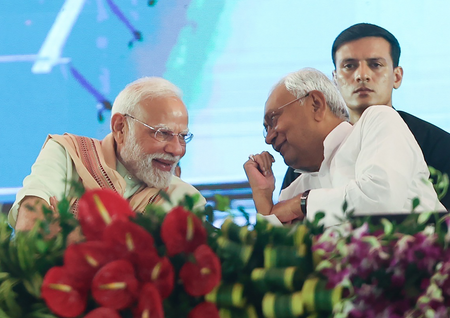
Patna, October 14 (IANS): The National Democratic Alliance (NDA) finalized its seat-sharing arrangement for the upcoming Bihar Assembly Elections after days of intense negotiations and vowed to keep the Opposition-led Mahagathbandhan at bay in state’s political circles.
As per the agreed formula, both the Bharatiya Janata Party (BJP) and the Janata Dal (United) [JDU] will contest 101 seats each, while the remaining 41 seats have been allocated to the NDA’s smaller allies. Among them, the Lok Janshakti Party (Ram Vilas) led by Chirag Paswan will contest 29 seats, while the Hindustani Awam Morcha (HAM) headed by Jitan Ram Manjhi and the Rashtriya Lok Morcha (RLM) led by Upendra Kushwaha will contest six seats each.
With the seat distribution finalized, the selection of candidates is expected to be announced soon, followed by a full-fledged campaign across the state.
The NDA government was first formed in November 2005, marking a turning point in Bihar’s political and administrative landscape. Since then, both the BJP and JDU have built an impressive electoral track record in the state.
Another notable point of NDA’s near two-decades governance in Bihar has been BJP’s consistent rise and clout in the state and also in the alliance. In the current Assembly elections, BJP and JD (U) are contesting on 101 seats each, marking a first in the hard-bargained seat-sharing deal.
In the 2005 Assembly elections, the BJP contested 102 seats, winning 55 with a strike rate of 53%, while the JDU contested 139 seats and won 88.
The 2010 Assembly elections saw the NDA register one of its best performances.
The BJP once again contested 102 seats and won 91, achieving a remarkable strike rate of 89%, while the JDU won 115 out of 141 seats it contested.
The first term of the Nitish Kumar government (2005–2010) is often described as a “golden phase” in Bihar’s governance, as the state began its recovery from the so-called “Jungle Raj” era.
The administration, led by Nitish Kumar and Sushil Kumar Modi, introduced several reforms focused on governance, infrastructure, and women’s empowerment.
Notably, the 50% reservation for women in Panchayati Raj institutions (2006) and urban local bodies (2007) significantly boosted the NDA’s popularity among women voters.
This widespread support helped the NDA secure a landslide victory in 2010.
However, political equations shifted in 2013, when Nitish Kumar broke away from the BJP following the announcement of Narendra Modi as the BJP’s Prime Ministerial candidate for the 2014 Lok Sabha election.
Despite a strong “Modi wave” in 2014, which gave the BJP a sweeping victory in the Lok Sabha polls, the scenario changed in the 2015 Bihar Assembly elections. Nitish Kumar joined hands with Lalu Prasad Yadav’s RJD and the Congress, forming the Grand Alliance (Mahagathbandhan).
In that election, the JDU and RJD contested 100 seats each, winning 69 and 80 respectively, while the BJP was pushed to the opposition. It had won only 54 seats.
However, in 2017, Nitish Kumar once again severed ties with the RJD, citing corruption charges against Tejashwi Yadav, and returned to the NDA fold.
In the 2020 Assembly elections, the NDA—comprising BJP, JDU, HAM, and Vikassheel Insaan Party (VIP)—contested together.
The JDU, which contested 115 seats, performed poorly, winning only 43 with a strike rate of 37%.
One major factor behind its setback was Chirag Paswan’s Lok Janshakti Party (LJP), which fielded candidates on 137 seats, many of which overlapped with JDU constituencies. The LJP’s presence split the JDU vote share, severely impacting its results—a point that Nitish Kumar himself has raised multiple times in public forums.
The BJP, on the other hand, contested 110 seats and won 74, with an impressive strike rate of 67%, emerging as the stronger NDA partner in the 2020 polls.
Political analysts believe that in Bihar, three forces—BJP, JDU, and RJD—dominate the electoral landscape, and whichever two unite often emerge victorious.
In 2025, the same pattern is visible again, with the BJP and JDU contesting together under the NDA banner against the RJD-led Grand Alliance.
This time, however, Chirag Paswan’s party is firmly within the NDA fold, eliminating the vote-splitting factor that hurt the alliance in 2020.
Apart from the NDA and Grand Alliance, Prashant Kishor’s Jan Suraj Party and Asaduddin Owaisi’s AIMIM are also contesting the polls and are expected to influence outcomes in several constituencies by cutting into both NDA and Grand Alliance vote banks.
As the campaign season intensifies, Bihar appears headed for a closely contested and high-stakes election, with the NDA banking on its governance record and unity, while the opposition seeks to capitalize on anti-incumbency and local issues.
Ends.
–IANS
ajk/mr



